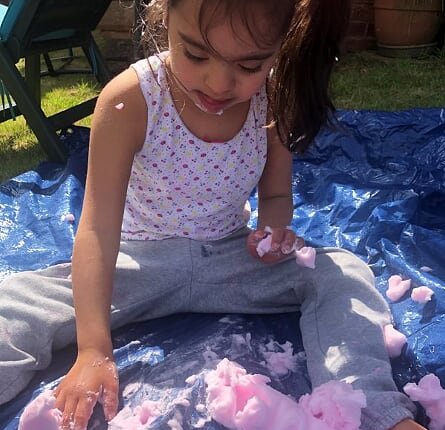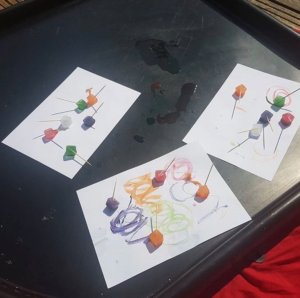14 Wet Messy Play Ideas for Children With Down Syndrome
Messy play is a lovely activity we can enjoy at home with our child. As well as being lots of fun, messy play provides our child with lots of development opportunities, providing sensory input and supporting fine motor skills, hand function and tool use.
Many children with Down Syndrome have trouble with different textures: either feeling too much (known as hypersensitivity, which can lead to tactile defensiveness) or not feeling enough (known as hyposensitivity, which leads to sensory seeking behaviours). Wet messy play is a controlled way to get large amounts of sensory input while your child has a great time.
Children who actively seek tactile inputs and love getting messy will really enjoy the ideas on this page. Those who are more sensitive to touch and prefer to stay clean will be better off starting with dry items – see our ‘Dry Messy Play’ page for some ideas.
It is important to be mindful that many sensory-seeking children are drawn to putting things into their mouths. If our child is likely to do this we need to make sure that the objects we give them to play with are non-toxic and safe.
Messy play is of course messy, so we need a bowl of water, a towel and/or wipes available nearby so our child can clean their hands when they want to.

Messy play allows for hand strengthening and developing hand-eye coordination. It provides a lot of sensory input and is a fun place for learning and developing gross and fine motor skills.
There is a strong cause and effect with messy play so children with limited fine motor skills can still make a big impact. This is great for learning and enjoyment.
Many children with different abilities have trouble with their sense of touch: either feeling too much (hypersensitivity, which can lead to tactile defensiveness) or not feeling enough (hyposensitivity, which leads to sensory seeking behaviours). Messy play is a controlled way to encourage tactile sensitive children to get used to different sensations. This can allow them to tolerate more of their everyday textures. The part of the brain which feels what is happening in the fingers and what happens in the mouth are close to each other in the brain, so if a child gets used to a texture with their hands it is going to make it easier to tolerate this in their mouth.
Feeling different textures is also good for stimulating brain development. Physical movements like two handed play and crossing the hands to the other side of the body during play, also helps brain development and body awareness.
Preparation is everything! Choose a place in the home or garden for messy play activities – ideally somewhere easy to clear up. You’ll need a surface to play on: tuff spot trays are brilliant for minimising mess, but you can also use trays or containers you already have in the home, or an easy to wipe playmat or table. You’ll also need water, wipes and a towel available nearby for washing hands. Decide what material you are going to play with in advance: some activities take a little while to put together, and you also might want to consider how to make them extra motivating for your child.
Choose a time to play where you are able to join in. Messy play should be an active experience that the child initiates in some way through imitation. If a child is nervous or unsure they might want to watch someone interact with the materials first, so you need to be prepared to get stuck in! Playing together with your child also means you can watch for ways to enhance or extend their play.
Before play, it’s really nice to massage, squeeze or brush your child’s fingers, hands and forearms. This alerts their system and brings awareness to the whole upper limb. A quick finger, hand or wrist stretch can also help them feel and manipulate the messy play substance more effectively, especially if they have tight hands.
The most straight forward play technique is to help your child put their hands in the substance and let them feel around.
If your child has movement limitations, it could be beneficial to use different parts of the body for messy play. Use their feet in the substance, or put them in the bath and allow them to get covered in the messy play! This extra sensory input will allow them to learn more about their bodies as well as being great fun.
If your child is able to hold objects, or with some hand over hand help, use kitchen utensils to play with the substance – using a wooden spoon to stir, a ladle or spoons to scoop or a potato masher to squish. You can use other things from around the home as tools to further develop motor skills, like paintbrushes, rolling pins, biscuit cutters, cutlery, containers, cups or sponges.
You can also put different objects into the substance for the child to play with. This is motivating and helps build fine motor and visual perception skills. Good options include cars, plastic animals or figurines. Try dropping some items inside the substance for your child to find. Start with bigger objects so they hardly have to touch the messy play mixture; as they get more confident, hide or make the items smaller so your child has to get their hands in.
Messy play is a brilliant opportunity for imaginative or pretend play. Making food out of play-dough for a dolls tea party, going shopping for items hidden in the messy substance or giving a baby a bath in some coloured yoghurt can offer a novel way to entertain your child.
If your child seeks tactile sensory input, try to mix sensations to give them a large sensory input – for example adding rice to yogurt or putting marbles in their play-dough.
If a child is wary about different textures, start at the top of the list and slowly make your way down as they get happier with each one.
Play-dough or alternatives
Make your own salt dough using salt, flour, water and oil. You could also try making Oobleck using corn-starch and oil, for a slightly different texture.Edible Paint or gloop
Make your own gloop using flour, salt, water and food colouring.Scented play-dough
This is fabulous for stimulating more senses as your child plays. Take a look at our ‘Our Home’ video.Cooked pasta
Add glitter or mix with other textures like sand to make the texture different.
To Introduce wetter messy play try:Whipped Cream
For young children who may use their mouth to feel the texture and eat it. Put it in a water tight zip bag for your child to manipulate. You could add some other toys into the bag which they need to identify or move around the bag to help get them used to the sensations. Or you could put it in a tray and get your child to make mini mountains. Make a track for cars to drive around or draw shapes and pictures with their fingers.Shaving Foam
Shaving foam provides a similar experience to whipped cream, however it may not be safe if your child brings these items to their mouth. The scent can also be strong and cause a gag reflex in certain children.Yoghurt
You can put toys or other textures in the yoghurt or dye the yoghurt and use it as paint.Baked beans
Use the beans to draw pictures. Use a spoon to pick them up if getting hands in it is too hard.Bubbles
Make bubble mixture from non-toxic soap and water or washing up liquid and water. Using bubbles to help eye hand coordination if great fun for your child as well as being beneficial. As an alternative to a standard bubble wand, try making a bubble blower out of a plastic drinks bottle. Cut off the bottom of the bottle, retaining the part with the spout. Secure a sock tautly over the cut end and dip into some bubble mixture. Blow through the spout to make thousands of little bubbles. Hours of fun.Add Additional Objects
Putting sand or wet rice crispies into your wet messy play can be helpful for children who struggle with lumpy soft food.Ice

Playing with ice can be an extreme sensory experience. Put some ice cubes in a bowl and, on a hot day, watch them melt in the sun. Let your child handle the ice as much as they feel comfortable to. They can use a spoon to handle the ice if it is too much for them.Ice Pens
Use food colouring in water and freeze to make ice pens!Frozen Veg
Use frozen veg in a sensory bin for your child to explore.Ice Cream
An extra delicious messy play!






